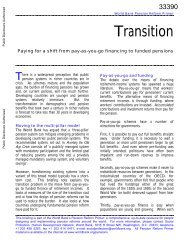Financial Sector Development in Africa: Opportunities ... - World Bank
Financial Sector Development in Africa: Opportunities ... - World Bank
Financial Sector Development in Africa: Opportunities ... - World Bank
You also want an ePaper? Increase the reach of your titles
YUMPU automatically turns print PDFs into web optimized ePapers that Google loves.
174 Fuchs, Losse-Mueller, and Witte<br />
<strong>F<strong>in</strong>ancial</strong> Report<strong>in</strong>g Standards, adopt<strong>in</strong>g cont<strong>in</strong>gency plann<strong>in</strong>g and bank<br />
resolution frameworks, and supervis<strong>in</strong>g microf<strong>in</strong>ance <strong>in</strong>stitutions ranked<br />
high on supervisors’ list of priorities. Although some of these efforts may<br />
follow a political rather than an economic rationale or may even be<br />
donor-driven, it is strik<strong>in</strong>g that <strong>Africa</strong>n supervisors often deal with a much<br />
broader reform agenda than their counterparts <strong>in</strong> developed countries.<br />
The breadth of the reform agenda documented <strong>in</strong> the focus groups is a<br />
challenge for the already constra<strong>in</strong>ed capacity of supervisors; many supervisors<br />
felt overwhelmed with the demands on them.<br />
The focus group discussions also <strong>in</strong>dicated that some <strong>Africa</strong>n supervisors<br />
already take a very pragmatic, build<strong>in</strong>g block–like approach to the implementation<br />
of <strong>in</strong>ternational standards. Some regulators have decided to<br />
<strong>in</strong>troduce risk-based supervision without implement<strong>in</strong>g the entire Basel<br />
II framework, while others focus on macro-prudential supervision as their<br />
priority. There is a strong consensus among <strong>Africa</strong>n supervisors that a<br />
more systematic approach to identify<strong>in</strong>g regulatory priorities was<br />
required to focus the reform agenda. In identify<strong>in</strong>g reform agendas, <strong>in</strong>ternational<br />
standards should not be viewed as a bluepr<strong>in</strong>t for sequenc<strong>in</strong>g<br />
reforms.<br />
Based on the discussion <strong>in</strong> this chapter, it is suggested that <strong>Africa</strong>n<br />
regulators adopt a “risk-based approach” to identify<strong>in</strong>g build<strong>in</strong>g blocks<br />
and develop<strong>in</strong>g country-specific roadmaps for regulatory and supervisory<br />
reforms. In do<strong>in</strong>g so, policy makers and their partners need to move<br />
beyond the classic assessment framework for f<strong>in</strong>ancial stability and<br />
develop a roadmap diagnostic framework that aids decision makers <strong>in</strong><br />
prioritiz<strong>in</strong>g certa<strong>in</strong> build<strong>in</strong>g blocks of the reform agenda over others.<br />
Any roadmap needs to be grounded <strong>in</strong> a set of basic supervisory conditions<br />
and requirements (for example, the availability of data, sound<br />
account<strong>in</strong>g practices, m<strong>in</strong>imum staff<strong>in</strong>g and resources, <strong>in</strong>dependence and<br />
authority of the supervisor) that will need to be <strong>in</strong> place before it makes<br />
sense to concentrate on other supervisory aspects or variations of the<br />
capital adequacy regime. These preconditions form a necessary foundation<br />
for implement<strong>in</strong>g country roadmaps.<br />
The choice of focus areas for reform should be based on an assessment<br />
of (the gaps <strong>in</strong>) exist<strong>in</strong>g regulations and supervisory capacity and the<br />
specific risk drivers <strong>in</strong> each country, for example, prevalent risk concentrations,<br />
or risks <strong>in</strong>herent <strong>in</strong> the f<strong>in</strong>ancial structure and the structure of<br />
the economy. National authorities should choose those build<strong>in</strong>g blocks<br />
that will have the greatest immediate impact on strengthen<strong>in</strong>g the effectiveness<br />
of f<strong>in</strong>ancial supervision and safeguard<strong>in</strong>g f<strong>in</strong>ancial stability.







